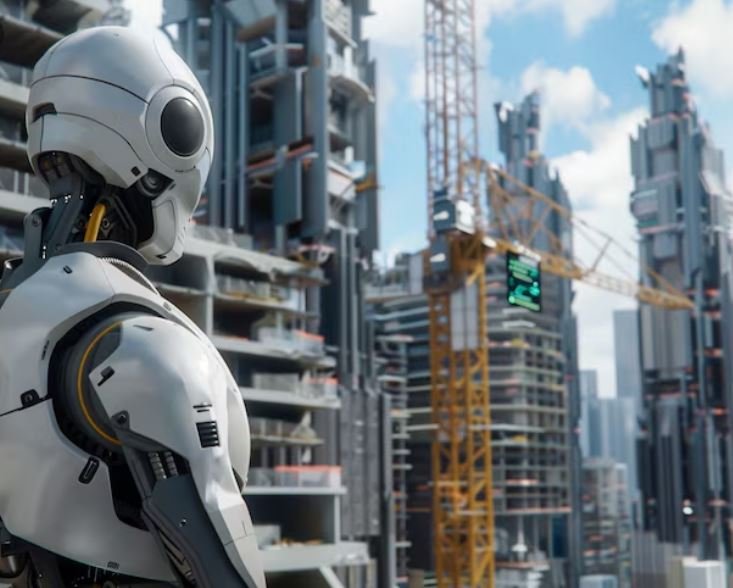
The term “construction crisis” is not used carelessly. Developers are looking to the next generation of robots, a workforce that never sleeps, never complains, and never takes a lunch break, as steel frameworks get longer and urban neighborhoods demand faster delivery. These machines, which operate in silence throughout the night, are changing strategies and skylines with a particularly inventive level of precision and at a speed that is far greater than any conventional crew could handle.
A former employee of Shimizu Corporation in Japan, Shinichi Sakamoto now works with Robo-Welders and Robo-Carriers in addition to site foremen. These are modern engineering workhorses powered by tablets and artificial intelligence, not science fiction artifacts. Sakamoto grinned while giving a tour of a high-rise in Osaka, pointing out how the materials were properly positioned, neatly stacked, and operated solely by robots during the night shift. It was a workable answer to the issue of the disappearing young builder, which has long dogged Japan’s industry.
| Feature / Trend | Description |
|---|---|
| 24/7 Robotic Labor | Robots operate continuously without breaks, accelerating construction timelines. |
| AI-Guided Precision | Millimeter-level accuracy minimizes costly rework and enhances build quality. |
| Modular Construction | Off-site robotic assembly streamlines installation and scaling. |
| 3D Printing Robots | Rapidly create structural components with minimal material waste. |
| Robotic Swarms | Coordinated units complete complex tasks simultaneously, improving speed and efficiency. |
| Addressing Labor Shortages | Robots fill persistent human labor gaps in construction trades. |
| Sustainability Improvements | Robotics optimize material use, lowering carbon emissions. |
| Robotic Safety Enhancements | Dangerous tasks like demolition and welding handled autonomously. |
| Data-Driven Decision Making | Robots gather and interpret live site data to support agile project management. |
| Reference Link | BBC News – Why Robots Will Build Future Cities |
Automation came to light as a solution rather than a threat in the context of demographic challenges. With no replacements in sight, one-third of Japan’s construction workforce is already over 54. Businesses are rebalancing their workforce by using robots to perform repetitive, heavy lifting, and welding tasks. This allows humans to oversee, design, and solve problems while machines perform with reliable consistency. This pattern is not unique. The average age of a construction worker in the United States is currently 43, and 80% of contractors say they have trouble finding qualified candidates.
Autonomous devices, such as the Hadrian X robot, are printing walls and houses in less than a day by utilizing lidar-based navigation and AI-powered sensors. In remote areas and disaster areas, where logistics restrict the use of traditional techniques, these robotic systems are especially helpful. It’s strangely hypnotic to watch the 3D-printing arm extrude precise layers of reinforced concrete; it’s like watching an artist’s brush at high speed. In Florida, a single robot completed a task that would normally take weeks: building an entire structure in a single day.
At the same time, modular building is becoming more popular. Complete wall panels, restrooms, or building cores are assembled with factory-level precision by robots operating in off-site facilities. These prefabricated modules significantly reduce on-site labor and noise disruption by snapping into place like building blocks once delivered. Construction is finally catching up to this method, which is remarkably similar to how Tesla streamlined automotive assembly.
An especially novel idea was presented by Nanyang Technological University in Singapore: robotic swarms. These small bots collaborate, printing, welding, and measuring while learning from each other’s movements, in contrast to solo units. Consider a swarm of bees that operate autonomously but are all directed by a common goal and the flow of information in real time. That is the goal of urban construction: quick, adaptable, and incredibly efficient.
The capabilities of AI have significantly improved over the last ten years. Without human assistance, robots can now comprehend terrain, adjust to changing conditions, and modify their routines. In a minor, symbolic achievement that showcased their recently developed dexterity, researchers at the UK’s National Robotarium showed off robots handling balloons delicately without popping them. Under the guidance of algorithms, these same hands are capable of installing ceiling boards, connecting wiring, and even accurately sorting recyclable materials at high speeds.
Robots are not only helpful but also necessary in the context of large-scale projects. Robots will be incorporated into every stage of the development and operation of THE LINE, a 170-kilometer linear city in Saudi Arabia. Long before a human eye could notice them, these machines are cleaning its mirrored facades, keeping an eye on the infrastructure below ground, and looking for flaws. Robotics presents a future that is not only incredibly efficient but also remarkably transparent in its execution path, as city planners strive for vertical, dense, and efficient urban layouts.
Additionally, drone-based inspections are becoming more popular. These robotic eyes continuously log data, detect micro-fractures, and take thermal images while hovering over bridges or scaling the sides of tall towers. Ground-based robots silently locate corrosion and leak locations by crawling inside sewers, ventilation shafts, and pipelines. Robots are preventing accidents and drastically lowering maintenance costs by changing inspections from reactive to proactive.
Safety, which is frequently a significant bottleneck, is being drastically rethought. Autonomous robots are now carrying out tasks that previously required rope teams, scaffolding, and risky climbs. These machines operate in hazardous demolition zones, high altitudes, and scorching deserts—environments too harsh for humans. By shifting the risks to steel and software, human life is less in danger and project dependability is noticeably increased.
Businesses like Mott MacDonald are incorporating robotics straight into project planning through strategic alliances. In order to ensure that infrastructure is constructed with machine collaboration in mind, their urban development teams now collaborate with robotics engineers from the very beginning. This strategy is highly adaptable in the field of smart infrastructure, allowing for everything from autonomous traffic lights to emergency response units that arrive on their own, are pre-stocked, and are connected to AI-based command centers.
Building companies are speeding up innovation timelines by working with organizations like the Robotarium. The distinction between manual labor and digital assistance is becoming increasingly hazy as humanoid robots are being tested for everything from installing elevators to caring for the elderly. Results are hard to ignore, but industry veterans’ emotional reactions are frequently cautious optimism. Results are more predictable, timelines are faster, and there are fewer injuries.
What appeared to be experimental has become standard in recent years. Drones mapping urban sprawl, robots welding steel frames, and robots laying bricks are no longer pilot projects. In places like Los Angeles, Tokyo, and Dubai, they are integral parts of large-scale development plans. Reinforcement, not replacement, is the key to their rise. It’s about allowing humans to concentrate on creativity, leadership, and design while letting machines do what they do best: precision, repetition, and endurance.
Construction sites will look more and more like orchestras in the years to come, with humans conducting and robots playing. Our skylines will be shaped more quickly, safely, and exquisitely thanks to this duet between code and craft. These machines are changing not only how we construct but also how we envision the spaces we will occupy in the future, much like the silent architects working behind the scenes.
